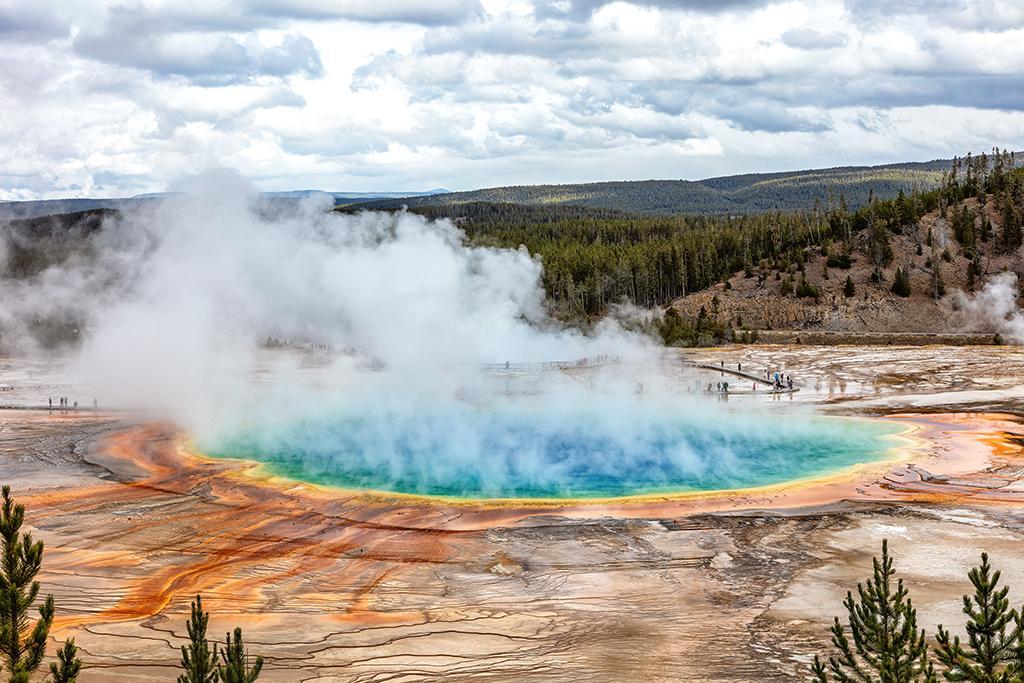 Recent earthquakes swarms in Yellowstone National Park and continued eruptions of Steamboat Geyser are proof that the park still is seismically active, though a new study suggests that the "hotspot" that fuels Yellowstone's geothermal fury has been in a "significant decline" for quite some time.
Recent earthquakes swarms in Yellowstone National Park and continued eruptions of Steamboat Geyser are proof that the park still is seismically active, though a new study suggests that the "hotspot" that fuels Yellowstone's geothermal fury has been in a "significant decline" for quite some time.
In May the famous geyser erupted five times, while nearly 300 earthquakes centered in the park registered on seismometers. The largest quake had a magnitude of 3.1 and was centered about 5 miles west of Norris Junction.
While impressive, that activity is nothing compared to some of the "super eruptions" associated with the Yellowstone hotspot. A new study in Geology claims to have discovered two eruptions from millions of years ago that included "the volcanic province's largest and most cataclysmic event," one covering an area the size of New Jersey. The results of that research indicate the hotspot "may be waning in intensity," the researchers say.
The team used a combination of techniques, including bulk chemistry, magnetic data, and radio-isotopic dates, to correlate volcanic deposits scattered across tens of thousands of square kilometers.
"We discovered that deposits previously believed to belong to multiple, smaller eruptions were in fact colossal sheets of volcanic material from two previously unknown super-eruptions at about 9.0 and 8.7 million years ago," says Thomas Knott, a volcanologist at the University of Leicester and the paper's lead author. "The younger of the two, the Grey's Landing super-eruption, is now the largest recorded event of the entire Snake-River-Yellowstone volcanic province."
Based on the most recent collations of super-eruption sizes, he adds, "It is one of the top five eruptions of all time."
The team, which also includes researchers from the British Geological Survey and the University of California, Santa Cruz, estimates the Grey's Landing super-eruption was 30 percent larger than the previous record-holder (the well-known Huckleberry Ridge Tuff) and had devastating local and global effects.
"The Grey's Landing eruption enamelled an area the size of New Jersey in searing-hot volcanic glass that instantly sterilized the land surface," says Knott. Anything located within this region, he says, would have been buried and most likely vaporized during the eruption.
"Particulates would have choked the stratosphere," adds Knott, "raining fine ash over the entire United States and gradually encompassing the globe."
The researchers say both of the newly discovered super-eruptions occurred during the Miocene, the interval of geologic time spanning 23-5.3 million years ago.
"These two new eruptions bring the total number of recorded Miocene super-eruptions at the Yellowstone-Snake River volcanic province to six," says Knott. This means that the recurrence rate of Yellowstone hotspot super-eruptions during the Miocene was, on average, once every 500,000 years, he added.
By comparison, Knott says, two super-eruptions have taken place in what is now Yellowstone National Park during the past three million years. "It therefore seems that the Yellowstone hotspot has experienced a three-fold decrease in its capacity to produce super-eruption events," says Knott. "This is a very significant decline."
Still, Knott said these findings have little bearing on assessing the risk of another super-eruption occurring today in Yellowstone.
"We have demonstrated that the recurrence rate of Yellowstone super-eruptions appears to be once every 1.5 million years," he says. "The last super-eruption there was 630,000 years ago, suggesting we may have up to 900,000 years before another eruption of this scale occurs."
But this estimate, Knott hastens to add, is far from exact, and he emphasizes that continuous monitoring in the region, which is being conducted by the U.S. Geological Survey, "is a must" and that warnings of any uptick in activity would be issued well in advance.



Add comment